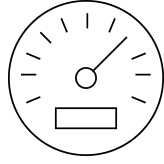
These five aspects, together with choice of material, define the productivity in your machines:
- High cutting data
- Prolonged tool-life
- Energy consumption
- Chip breaking
- Surface finish
The total productivity potential for a machining process is all about the interaction between material, cutting tools and machines. The right material can enable higher cutting data while at the same time prolonging tool life.
High cutting data and tool life
High cutting data and tool-life often counteract each other. Meaning if you increase the cutting data, you will lose tool-life. This may be true for some materials but does not apply to Sanmac. It is possible to increase productivity using higher cutting data, while at the same time prolonging tool life considerably.
The reason for this relates to the microstructure of the material. At Alleima, we use non-metallic inclusions to manipulate the microstructure. When the work piece is heated up in the cutting zone, it will yield a lower mechanical load. This also generates less heat in the insert. Heat is one of the main factors affecting the tool life of an insert. If it can be kept to a low level, there is room to increase the cutting speed, leading to higher productivity. The non-metallic inclusions also generate less mechanical wear on the insert, providing longer tool life.
Energy consumption
Both energy consumption and chip-breaking are also closely related to microstructure. In our hot working process, we ensure that the material has an even and optimized microstructure throughout the length of the bar. This gives very predictable machining, with the lowest possible energy consumption. An uneven microstructure would directly affect the tool-life and give uneven component quality.
Chip breaking
Chip-breaking is always a challenge in stainless steels and especially duplex stainless steels. This is due to the high material strength of the material. Here our material know-how is even more important. Many stoppages in the machine are related to chip breaking. Either the chip has fastened to the tool or work-piece, or in the conveyor. Stoppages like this are often hazardous for the operator and take time to solve. Time that could be spent running the next part, or even maintaining a second machine? Having chip breaking under control means a reduction of unwanted stoppages and more output from the machining process.
Read more about chip breaking in austenitic and duplex stainless steels
Surface finish
In most machining processes there is a finishing cut, the purpose of which is to produce a high integrity finish on the part in terms of tolerance or simply perception. In both cases, this means that no imperfections are permitted that could leave a spot or mark on the surface. We ultrasonically test our bars, to ensure that no imperfections in the bar will ever reach our customers.
The total productivity potential for a machining process is about the interaction between material, cutting tools and machine. The choice of cutting tools and machine is vital, but by selecting the right work-piece material, these can be greatly influenced. By purchasing material from a trustworthy manufacturer that always provides consistency, material that is easy to cut and acceptable chip-breaking, then you have the prerequisites to get the most out of your machine and cutting tools. This is the foundation of your production system, enabling you to take your overall productivity and cost reduction per component to the next level.